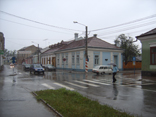Reflections
Oasis of Torah and Chassidus
Sighet – Town of Torah and Chassidus, on the occasion of the Yahrzeit of Rabbi Yehuda Kahana, Rav of Sighet and author of ‘Kuntress HaSfeikus’. 5379
Sighet was a metropolis of Judaism for almost two centuries. One of its first leaders was Rabbi Yehuda Kahana, author of ‘Kuntress Hasfeikos’, a commentary on the Shulchan Aruch - Choshen Mishpat. It is a reference guide to the Sefer his esteemed brother Rabbi Aryeh Leib HaCohen had authored – the famous Ketzos HaChoshen. Both of these works are essential components of every Torah library, and will always be found on the desks of erudite Torah scholars.
The extensive Kahana family, descendants of Rabbi Yehuda Kahana, numbered over two hundred members. Because of their illustrious lineage the family was held in high regard by the people of the town, and as several branches of the family had become very wealthy, they had the final word on many public issues. Their opinion was heard on every matter of import in the town. Of particular renown was the wealthy Rabbi Kalman Kahana, who owned over one hundred fifty houses in the town, in addition to a few thousand dunam of agricultural land and forests in the Marmarosh region. There were many Torah scholars in the family too, who held places of honor in the family tree - amongst them Rabbi Yehuda Mudaran, student of Rabbi Moshe Sofer the holy ‘Chasam Sofer’, who stood at the helm of the Yeshiva in Sighet. Rabbi Yehuda did not want to take position as Rav of the town, but his name became known throughout Hungary for his piety, and he published two of his works – ‘Zichron Shmuel’ and ‘Pri Etz’.
The Kahana family wanted to bring the famous Rabbi Elazar Nissan Teitelbaum of Ujhel, son of the Gaon Rabbi Moshe Teitelbaum (the ‘Yismach Moshe’), to serve as Rav of the town. The townspeople however, who were mostly Kossover Chassidim, were opposed to this choice and a great dispute broke out in the town.
The Marmarosh region was home to many types of Chassidus. Many Admorim had set up their courts in this part of Hungary, thus the matter of who would hold positions of leadership in the large towns was a constant cause of dispute and strife. So it was that the Kossover Chassidim in Sighet were unhappy about the position Rabbi Elazar Nissan held in the town - they claimed that since he conducted himself as an Admor, he was likely to infringe on the honor of their Rebbe. In wake of this dispute, Rabbi Elazar Nissan Teitelbaum left Sighet and moved to Drohovitz in Galicia, to serve as Rav.
Eighteen years after this incident, the town of Sighet was once again in need of a Rav. The Kahana family wanted to appoint their relative Rabbi Yehuda Mudaran as Rav, but he declined. Against their will, the son of Rabbi Elazar Nissan Teitelbaum, Rabbi Yekusiel Yehuda Zalman Leib, was brought in to serve as Rav of Sighet. Rabbi Yekusiel had been brought up in the home of his grandfather, the ‘Yismach Moshe’.
With the rise of the Teitelbaum dynasty in Sighet, the pride of the Kahana family slowly dwindled and ebbed away. At first there was opposition to the appointment of Rabbi Yekusiel as Rav on the part of a small, isolated group in Sighet, but over the years the level of Torah-observance in this faction declined as members of the ‘Maskilim’ (enlightenment) took up residence there and made their mark. As a result, many of the better members left this smaller community for the larger and stronger community headed by the Teitelbaum dynasty.
Numerous different groups of Chassidus presided in Sighet and Pavaria, but the major faction was Kossov and Vizhnitz. Together they ensured that Sighet would remain a ‘mother city’ for Hungarian Jewry. The atmosphere in the town was a glorious blend of Torah and Chassidus. The Rebbe led the main Yeshiva there, and many students from throughout the Marmarosh belt came to study there and the sound of Torah permeated the streets of Sighet. The Rebbe invested tremendous energy in the education of the youth, and guided the people in Torah and fear of Heaven.
During the week the people were busy earning their livelihood, but on Shabbos eve they would gather to learn Gemara and Shulchan Aruch and to hear words of Torah and Mussar – each in the study hall of his own Chassidus.
Throughout the years until the Second World War, the town of Sighet was led by descendents of the Teitelbaum family, who were surrounded by many students and followers. A Chassidic dynasty emerged that was transferred from father to son. Today, this is part of the Satmar Chassidus that was a central element in Jewish Sighet, up until the days of the Second World War.







